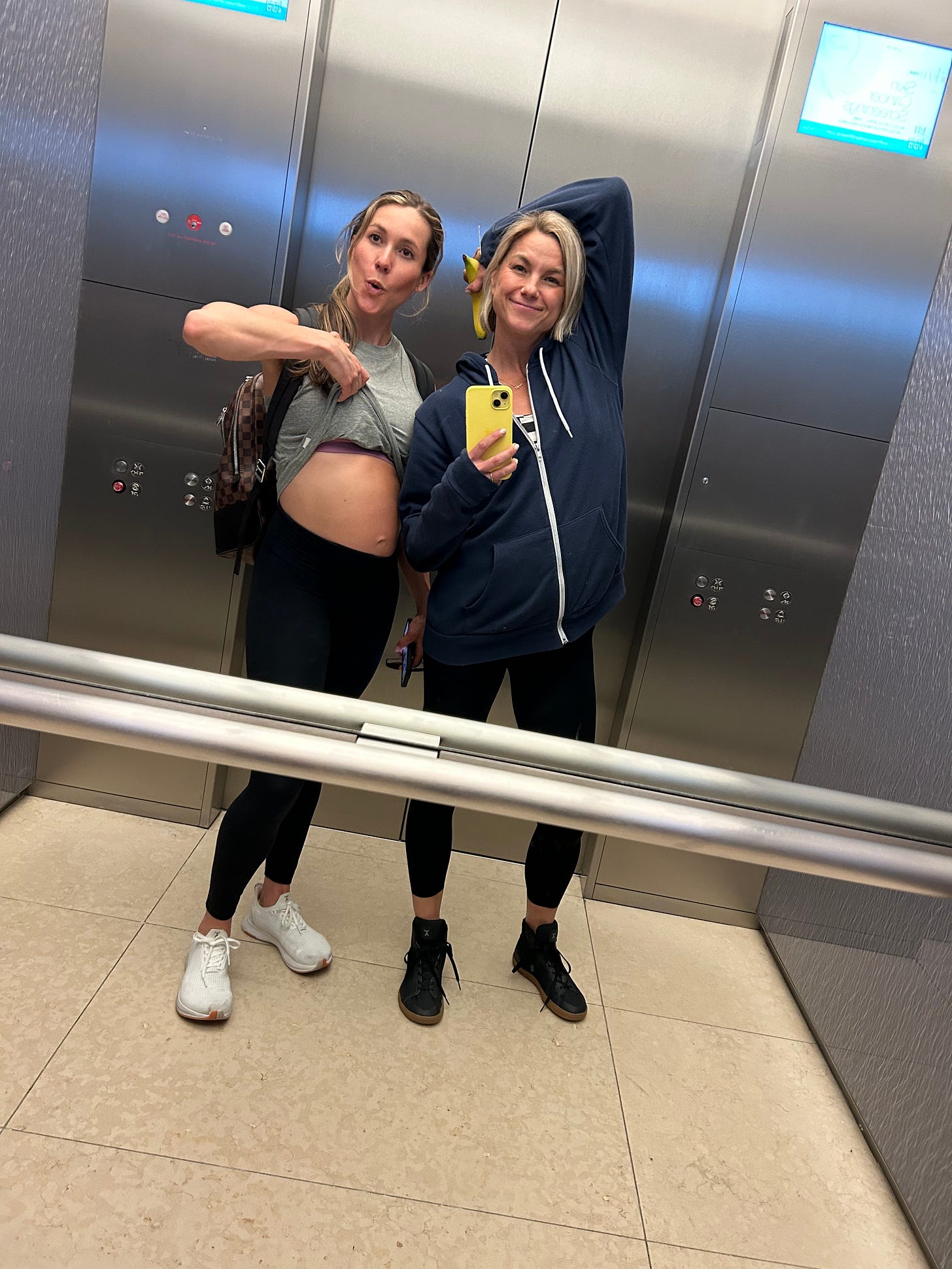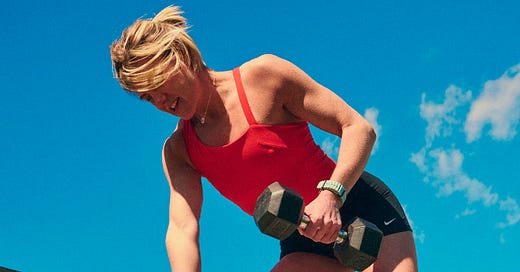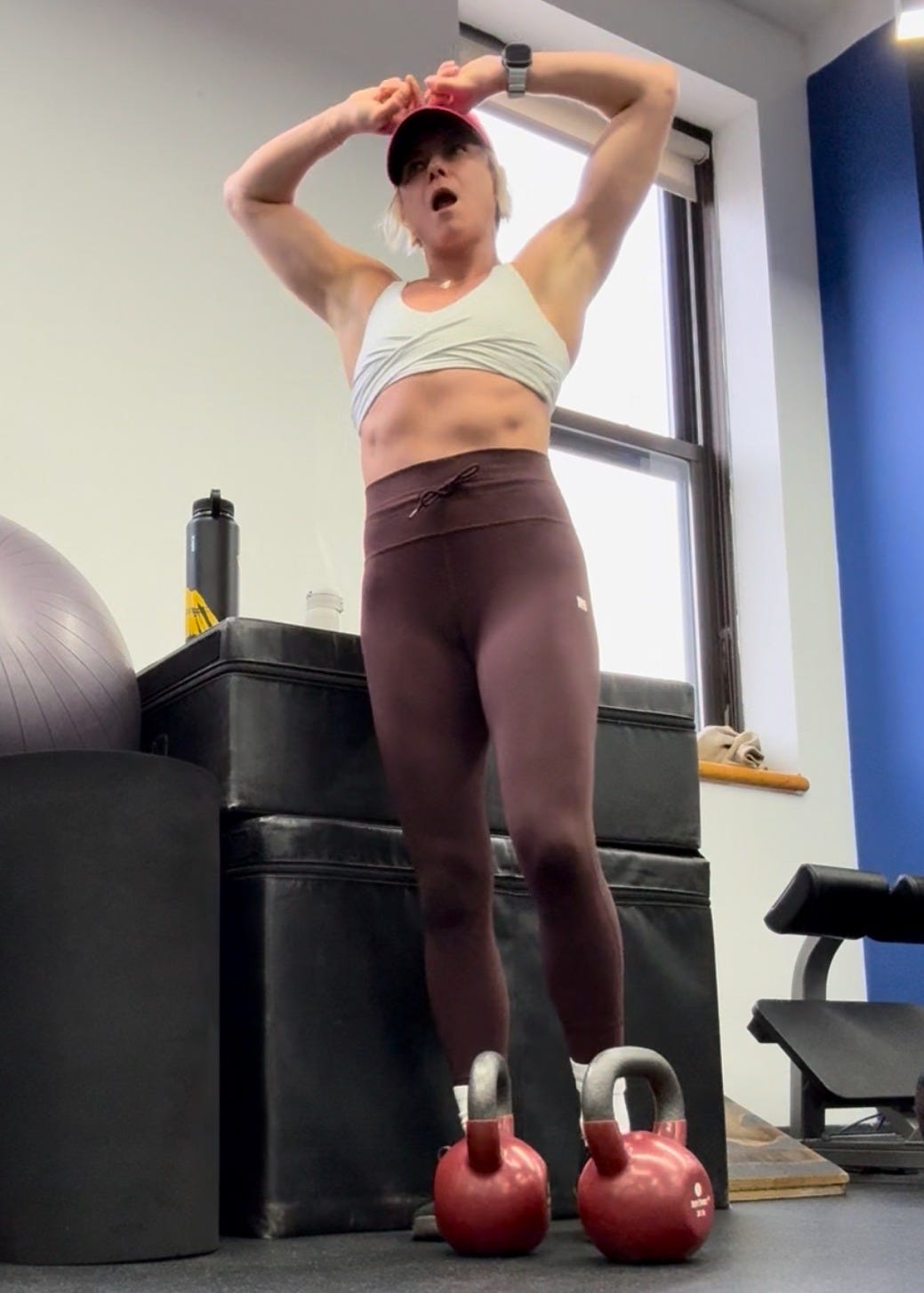"People don't think it's a 'good' workout unless they're dead on the floor in a pool of sweat."
Let's get real about how much HIIT we *actually* need in our lives.
“I’m giving you 90 seconds of rest and you should be lifting a heavy enough weight that you need every second of it,” said the trainer’s voice in my AirPods. “This is not a HIIT workout. We’re training absolute strength.” As the countdown timer dinged, I sipped from my water bottle and got into position for my third set of eight controlled single-arm row reps with a 45-pound kettlebell.
The scene above plays out four mornings a week at my local YMCA in Brooklyn. I use the Ladder workout app, and am on a kettlebell-focused team called Body&Bell, where thousands of women and men of all ages, from all over the world, follow strength training plans programmed (and then demo’ed and narrated) by Lauren Kanski.
Lauren is a long-time, close friend of mine. But that’s not why I train with her. I do that because I love her workouts. They make me feel clear-eyed, confident, calm. They help protect me against many of the (sometimes unpleasant) effects of aging. And they never, ever leave me feeling beat up or exhausted.

“Strength training should give more than it takes from you,” Lauren told me on FaceTime this morning. It’s something I’ve heard her say—many different ways—for as long as I’ve known her. And she’s right. Fitness is not supposed to decimate you…at least not every time you sweat. It’s supposed to help you get healthier and stronger, and also leave you with (or better yet, deliver to you) the energy to give 100% in everything else in your life.
Today’s post will feel controversial to some: In the wellness world, the only thing that fires up people more than defending their workout of choice is championing their particular approach to nutrition…
So let me say it right out of the gate. As a certified trainer, longtime health journalist, and a person on a mission to help people fall in love with fitness, I am not “anti” any type of workout. Quite the opposite. I constantly encourage people to find a form of exercise they love: That’s the best way to ensure consistency. (And joy!)
And me? I love HIIT, Pilates, tennis, urban rucking, hiking and Hyrox, swimming, EZ runs in the park with my dog, and dancing in the kitchen while prepping dinner…many modalities that have nothing to do with resistance training. (I have not competed in a Hyrox event yet. Someday!)
But after years of verge-of-puking HIIT sessions at Tonehouse (IYKYK) and endless burpees in The Class, now my MO is to pulse those high-intensity cardio bouts into each week rather than make them my regular go-to. Do what lights you up, please, but don’t roll your eyes at strength training. We can’t afford to neglect it.
First, A Primer On HIIT And Strength…
“People don’t understand that HIIT and strength are two completely different things,” Lauren told me. “I’m not saying they don’t complement and boost each other, but they should be trained separately for the best results on each front.”
Here’s the deal: HIIT is a form of anaerobic conditioning, rather than muscular training. Yes, read that again. If you’re doing HIIT, you’re doing cardio/conditioning…you’re simply not sparking much muscle growth.
HIIT (High-Intensity Interval Training) primarily focuses on improving cardiovascular fitness and burning calories, often by alternating between short bursts of intense exercise and lower-intensity recovery periods. It can involve bodyweight exercises, sprints, cycling, or other high-intensity activities.
“For absolute strength, we need more rest [in between sets] to optimize force output,” Lauren says. “People don’t think they’re getting a good workout if they aren’t dead on the floor in a pool of sweat like [you feel] after HIIT. When instead, they could increase their strength gains by taking sufficient rest.”
To be clear: On days I’m lifting? I’m pushing myself, my muscles are quivering, and I need my breath to help me through the range of motion. But I’m also adequately resting in between sets….it’s not a non-stop gerbil wheel of lung-searing effort.
Strength gains occur when muscle fibers experience progressive overload, which typically happens through resistance training (with weights or bodyweight exercises), stimulating muscle growth. Hypertrophy is best achieved with moderate to heavy loads (around 65–85% of your one-rep max) and sufficient volume (reps and sets) to feel muscle fatigue.
Getting stronger creates a cascade of positive body benefits, including...
Let’s Talk Lean Muscle Mass
As we get older, particularly after 40, we lose muscle mass in a process called sarcopenia. This decline accelerates during perimenopause and after menopause due to hormonal changes, such as reduced estrogen levels, which adversely affect muscle mass and strength.
Sarcopenia is the age-related loss of muscle mass and strength, accelerating in women after menopause and impacting overall health and mobility.
Studies have shown that for women navigating the menopausal transition, lean body mass decreases by approximately 0.5% annually, while fat mass increases by about 1.7% per year. This shift not only impacts our physical strength but also our metabolism and overall quality of life.
HIIT workouts, while excellent for your cardiovascular system and fat loss, don’t target muscle mass like resistance training does. Strength training has consistently been shown to not only slow down but reverse muscle loss in midlife women, per a recent study in Frontiers In Physiology. I know you love those vibe-y red lights at Barry’s Bootcamp and furiously pedaling to Peloton’s playlists—me too—but many scientists call muscle the ultimate longevity organ. We gotta muscle up.
Resistance training preserves—and even increases—muscle mass in postmenopausal women. A 20-week study demonstrated that systematic resistance training with free weights significantly improved strength and body composition in women aged 40–60.
Additionally, lifting three times per week, for sessions lasting between 20 to 90 minutes over at least six weeks, enhanced muscle mass and strength in menopausal women, according to a comprehensive review of studies in the BMC Women’s Health journal. (FWIW, my workouts take 45-60 minutes.)
Strength training also plays an MVP role at the cellular level: It directly stimulates type II muscle fibers, which are the fast-twitch ones responsible for generating quick, powerful movements like sprinting, lifting, and reacting to prevent falls. Which is awesome, because these same fibers are at risk of atrophy, particularly during and after menopause.
HIIT workouts are tops for cardiovascular fitness, and they tend to favor endurance adaptations in type I (slow-twitch) fibers. They don’t provide the sustained, progressive overload stimulus needed to recruit and maintain fast-twitch fibers over the long term.
Moderate-to-intense resistance training creates the mechanical tension needed to activate fast-twitch fibers and stimulates muscle protein synthesis, leading to improved strength and hypertrophy, according to a recent systematic review in the journal Menopause.
If You Want To Change Your Body Composition…
The relationship between meno, hormones, and metabolism is often oversimplified. So let me start here: No, perimenopause does not tank your metabolism overnight. Resting metabolic rate (RMR)—the number of calories your body burns at rest—does decline with age, but studies show the decrease is more related to loss of lean muscle mass, changes in physical activity levels, and aging in general, rather than menopause itself.
(Metabolism remains surprisingly stable from ages 20 to 60 and only declines after that, according to a recent study in the journal Science, again, suggesting menopause alone doesn’t cause a drastic metabolic drop.)
But menopause indirectly impacts metabolism. When estrogen levels fall, women tend to gain fat mass and lose lean muscle mass, particularly in the abdominal region. This shift in body composition leads to a relative decline in daily energy expenditure—even if RMR doesn't nosedive overnight.
For those who are interested in losing weight, I understand that calories may be on your mind: how many you’re consuming, and how many you’re burning. Obviously, you might be thinking, it would make sense to go destroy myself with HIIT and burn as many calories as possible?
But actually, no. At least not regularly. Because here’s the thing…your cute fitness tracker can’t quantify how lifting levels-up your resting metabolic rate (RMR). And your RMR? It’s stoked you’re strength training: This study, for example, found that a 16-week resistance training program in postmenopausal women resulted in an average RMR increase of 110 kcal/day, equating to an 8.4% rise. That’s on top of whatever number of calories you did or didn’t burn during your workout. (I don’t even look at that number.)
As long as we’re talking body comp, it’s worth pointing out that strength training enhances insulin sensitivity. That’s a good thing. A 15-week resistance training regimen decreased abdominal adiposity in postmenopausal women, helping to mitigate menopause-associated fat redistribution, per a study in the journal Maturitas.
Better Bone Health
I don’t know how old you are, but whether it’s you, a friend, or your aging parent, consider this: If we have weak bones, falling can lead to a life-or-death injury.
Bone density peaks in your late 20s to early 30s and begins to decline thereafter, with women experiencing a more pronounced decrease post-menopause due to hormonal changes. This decline increases the risk of osteopenia, osteoporosis and fractures.
Prioritizing calcium and vitamin D through your diet and/or supplements will help, but strength training will also provide a powerful bone-strengthening stimulus. Resistance training protocols were more effective than other exercise modalities in improving bone mineral density (BMD) in postmenopausal women, in a 2022 meta-analysis in the journal Osteoporosis International.
Strength workouts counteract this progression (er, regression?) by applying mechanical load to your bones, and stimulating bone formation while improving BMD. Moderate-intensity resistance training performed three times per week significantly enhances BMD at critical sites such as the lumbar spine and femoral neck in postmenopausal women, per a study in the journal Frontiers.
Life is tough, we could all use some help showing up as our best selves all day, every day.
The Pink Cloud Effect
Spoiler! There are no winners or losers here, all workouts get gold stars.
That high you feel as you mop your sweat off the floor after finishing your favorite HIIT workout? That’s real. There is no question that HIIT workouts boost mood by sparking endorphin release.
I used to think I could only get that pink cloud feeling from HIIT and marathon training, but eventually I figured out how to find it in strength training. (Psst: Pick up a heavier weight.) I can confirm that I have more confidence, emotional resilience, self-esteem and mental toughness thanks to my kettlebell workouts.
This all tracks on the research side, because strength training has been shown to significantly improve cognitive function, mood, and self-esteem—effects likely related to the physical empowerment and neurological benefits of lifting weights, according to research in the journal Frontiers in Neuroscience.
You know this, but it bears repeating: Mental wellness is just as crucial as physical health. Between caring for aging parents, navigating life with young children or hormonal teens, the state of the world, etc., life is tough. We could all use some help showing up as our best selves all day, every day.
The Final Whistle
This all leads me to my parting selfie. If I were your trainer, I’d make sure you were hitting the moves below at least a couple of times a week. And I’d tell you to keep picking up heavier weights—outside of your comfort zone—as your form, confidence and strength improve.
Squats
Rows
Loaded carries
Deadlifts
Overhead presses
Lunges
Pushups
I’d also tell you to keep doing what you love, whether that’s rucking or HIIT or dance cardio or whatever lights you up. Getting stronger, healthier, and more resilient without feeling like you have to/should crush yourself every time you show up for a workout? That is pretty much the ultimate flex.
Reporting and writing this took a lot more effort than deadlift day, so do me a favor and share a comment below.👇 I’d love to hear how your workouts have evolved and how they make you feel…or if anything in today’s piece surprised you. Sincerely, A recovered marathoner, Half-Ironman’er, and boutique fitness frequenter







Thank you so much for this article! I have been a long distance “slow” runner for years trying to outrun those calories. It took a long time to actually listen to my endocrinologist who said lift more weights. He knew all those years ago, way before it became a thing. Now I have joined the over 50 club and follow the Galloway method along with lifting heavy 4x a week. Best decision to make the change over!
I used to avoid weightlifting because I didn't want to get bulky. But since I started strength training, I have noticed it's the easiest way to burn 1000 calories a day.. I don’t go above 10kg, though.